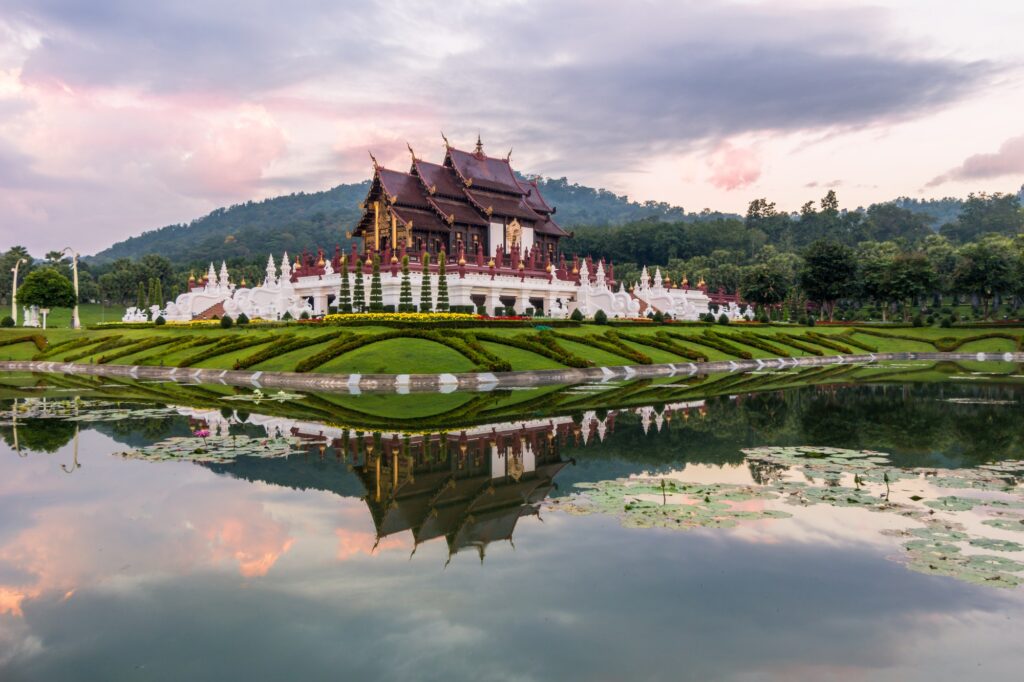Richard and I are trekking back to Chiang Mai from spending a week at the Four Seasons Elephant Camp in Chiang Rai, actually in Chiang Sean, northeast of Chiang Rai. I say “trekking back” because we spent one night at the four Seasons Resort Chiang Mai before going to the Tented Camp. That is a story for another time. It involves a lost plane reservation by Priceline.com that stranded us in Bangkok for several hours. That issue aside, if you are looking for places to travel in Southeast Asia you should consider Chiang Mai.
Four Seasons Chiang Mai
We were really looking forward to our week stay at the Four Seasons in Chiang Mai. This Four Seasons is entirely different in that it is based on the idea of being in a small Thai farming village with rice paddies and resident water buffaloes. This is another example of Ben Bensley’s tremendous architectural and landscape design talents. Chiang Mai Four Seasons Resort is one of Ben’s first resort garden designs. His vision transformed an ordinary rural landscape into a beautiful, verdant oasis on the outskirts of Chiang Mai.
Four Seasons Small Thai Village
This Four Seasons Resort has evolved over the years since it was first opened in 2010. The “small Thai Village” concept expanded with a few larger villas added, hidden, under the trees around the central lake and rice paddies. The Resort just opened the new pool, spa and lounge area when we were there. It is quite magnificent. The three main restaurants, Khao, North, and Rim Tai Kitchen, recently received recognition from the Michelin organization for its level of food preservation and preparation. There is also private dining in the Rice Barn overlooking the lake.
Rice Paddies
Because of our responsibilities with the rice plantings and the bathing of the water buffaloes we did not allow for the time needed to adequately explore the Old City of Chiang Mai as we should have.
Chiang Mai Provence
Chiang Mai is a fairly large city and province with its population estimated to be around 1.7 million people. Since it is also the provincial capital it has a population of around 170,000 people. The land area is similar size to that of Phoenix, Arizona, or around 7,348 square miles.
The Chiang Mai Old City
Allow yourself enough time to leisurely visit the surrounding Chiang Mai area especially in the historic Old City. Within its ancient walls, you’ll discover a treasure trove of stunning temples, each with its own unique charm and significance. Among them, two temples stand out: Wat Phra Singh and Wat Chedi Luang.
Temples and a Palace
At this point of our trip we were somewhat “Templed Out” and did not want to spend an extended amount of time visiting more temples. They each started to look like one another. We do think the following sites offer a unique perspective on the religious background of the region.
Wat Phra Singh

This temple is also known as the “Temple of the Lion Buddha”. It is one of the most significant and revered temples in Chiang Mai. The temple dates back to the 14th century and houses the famous Phra Buddha Sihing statue.
Wat Chedi Luang

Wat Chedi Luang, is another historical site you might want to consider in the Old City. It has an impressive Buddhist monument, called a Chedi, that rises 260 feet majestically into Chiang Mai’s skyline. Apparently the temple has undergone both destruction and restoration over the years, adding layers of history and cultural significance to its surroundings.
Wat Phra That Doi Suthep

Doi Suthep is located on a mountain just outside of Chiang Mai and requires extra time and transportation in order to visit. It is home to one of the most sacred temples in northern Thailand, Wat Phra That Doi Suthep. The temple’s striking golden chedi is visible from various points in the city. A chedi, curiously, can be any size or shape. It can even be just a mound of dirt. The climb to this temple entrance is somewhat strenuous. Forrtunately there is also a cable car to the top. Either way, the scenic views from the top are stunning.
After exploring Wat Phra That Doi Suthep, try to visit the terraced area that offers panoramic views of Chiang Mai and its surroundings countryside. On a clear day the vista is quite impressive with the bustling city below contrasting against the lush mountains in the distance.
Bhubing Palace

The Bhubing Palace is the royal family’s residence during their visits to Chiang Mai. The Palace is set in the serene beauty of Doi Buak Ha Mountain. Bhubing Palace is surrounded by well-manicured gardens, stunning flowers, ornamental trees, and meticulously maintained landscapes.
One highlight that was of interest to us was the greenhouse at Bhubing Palace. Over the past two years we have had a love / hate relationship with growing orchids. The Royal Greenhouse grows a variety of orchids and offers their tips of successful orchid cultivation. It is still to be seen as to whether their insight was helpful.
Making time for the cultural and historic sites can be very rewarding and definitely exhausting. Returning to ultra luxurious Four Seasons Resort is the reward.
Fulfillment and Appreciation
At the end of each day we lounge in our our plunge pool, looking out over the rice paddies we helped plant and then over to the farm yard area where our cleaner water buffaloes are kept, gives us a sense of fulfillment and appreciation of the Southeast Asian way of life, their culture and their cuisine.









1 thought on “Chiang Mai”
I really enjoyed reading this post. I want to go to Thailand now, thanks!